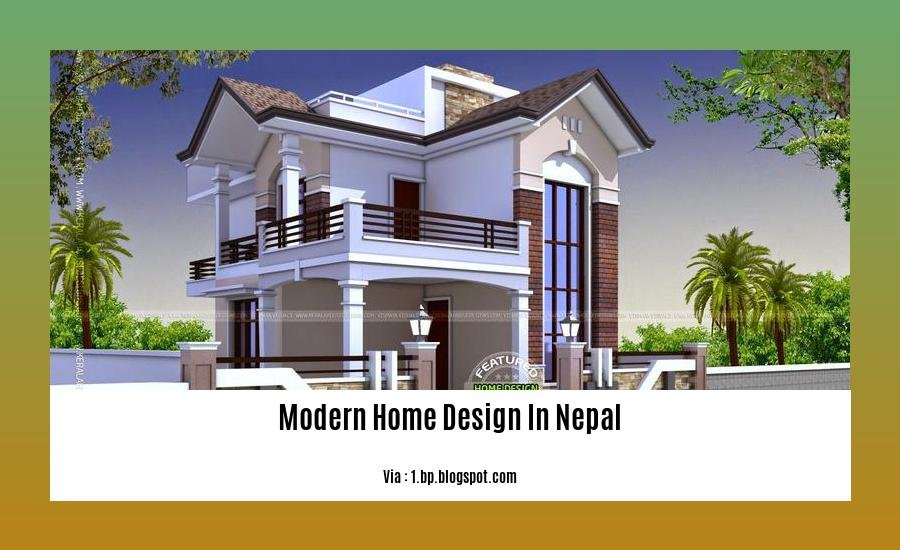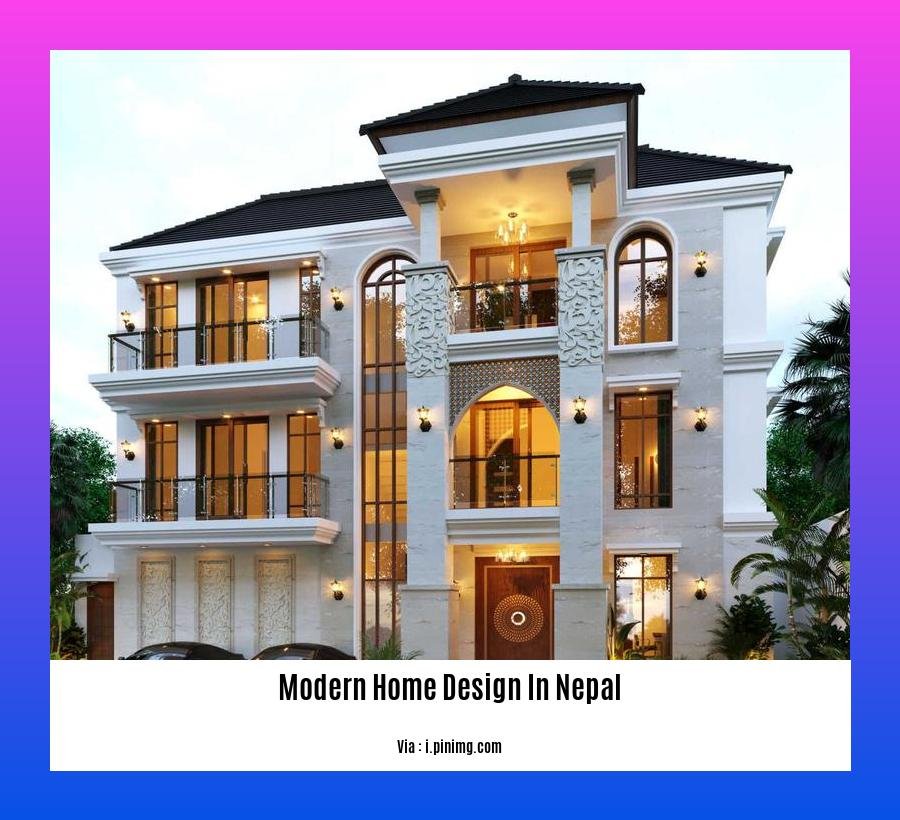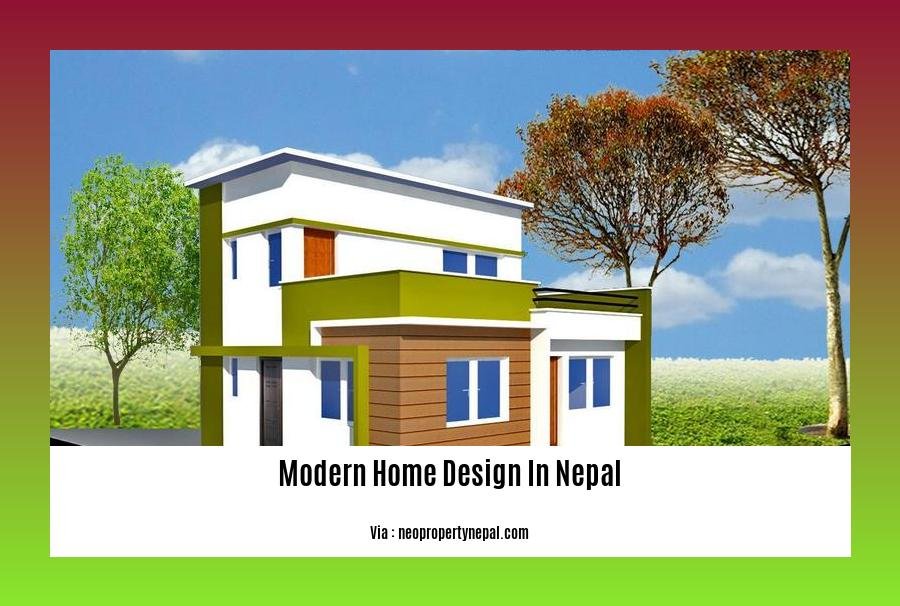In the realm of architecture, Nepal is emerging as a hub for modern home design that seamlessly blends style and sustainability. This guide, titled “Modern Home Design in Nepal: A Guide for Creating Stylish and Sustainable Spaces,” will provide valuable insights into the evolving landscape of residential architecture in Nepal.
Key Takeaways:
-
Two-story house design blends traditional Nepali and contemporary architecture, combining striking exteriors with a unique mix of styles.
-
Contemporary design embraces clean lines, minimalism, modern materials and technology, open spaces, natural light, and a neutral color palette.
-
Earthquake-resistant new house designs prioritize a strong foundation, stable structural systems, seismic isolation, and damping systems. Proper building layout and mass distribution play a crucial role.
-
Brahman House, a representation of traditional architecture, utilizes common rural materials like stone, clay plaster, and thatch to create charming spaces.
Modern Home Design in Nepal: Embracing Sustainable Style

Nepal, a land of breathtaking natural beauty and vibrant culture, is witnessing a surge in modern home design. This architectural movement, characterized by its clean lines, sustainable practices, and integration of contemporary style with traditional elements, is reshaping the residential landscape of the country.
Embracing Modernity While Honoring Tradition
Modern home design in Nepal seamlessly blends the essence of traditional Nepali architecture with contemporary aesthetics. From the intricate carvings adorning traditional houses to the use of natural materials like stone and wood, modern homes pay homage to Nepal’s rich cultural heritage.
At the same time, modern designs embrace the principles of sustainability and functionality. They prioritize energy efficiency, incorporate natural light, and promote indoor-outdoor living spaces, reflecting the evolving lifestyles of Nepali homeowners.
Unique Features of Modern Nepalese Homes
-
Integration of Natural Elements: Nepalese homes often feature large windows and open spaces that blur the boundaries between indoor and outdoor living. This connection to nature fosters a sense of tranquility and brings the beauty of the surrounding environment into the home.
-
Sustainable Materials: Modern Nepalese homes often utilize locally sourced and sustainable materials such as stone, wood, and bamboo. These materials not only reduce the environmental impact of construction but also showcase the natural beauty and craftsmanship of Nepal.
-
Cultural Influences: Traditional Nepali design elements, such as intricate carvings and colorful accents, are often incorporated into modern homes, creating a unique blend of old and new. These elements add a touch of cultural heritage to the contemporary design aesthetic.
-
Functionality and Simplicity: Modern Nepalese homes prioritize functionality and simplicity. Clean lines, uncluttered spaces, and efficient layouts create a sense of order and harmony, promoting a comfortable and practical living environment.
Creating a Sustainable Future
The rise of modern home design in Nepal presents an opportunity to promote sustainable practices and reduce the environmental impact of the construction industry. Architects and designers are exploring innovative ways to integrate renewable energy sources, such as solar panels, into home designs. Additionally, green building techniques, such as rainwater harvesting and waste management systems, are gaining popularity.
By embracing modern design principles, Nepali homeowners can create stylish and comfortable living spaces while contributing to a more sustainable future. This movement has the potential to transform the architectural landscape of Nepal, showcasing the country’s commitment to innovation, sustainability, and cultural preservation.
-
Elevate your home’s aesthetic with our stunning collection of modern contemporary furniture. Shop now and transform your space into a haven of modern elegance.
-
Discover the charm of modern country homes with our modern country home designs Australia. Browse our captivating gallery and find inspiration for your dream home.
-
Experience the epitome of modern living with our modern house design prices. Explore our range of affordable and stylish designs and create a home that reflects your unique taste.
Use of sustainable materials and eco-friendly practices in modern home design in Nepal

Sustainability and eco-friendly practices are key considerations in modern home design in Nepal. By incorporating sustainable materials and eco-friendly practices, architects and homeowners can create homes that are stylish and comfortable while minimizing their environmental impact.
Some commonly used sustainable materials in modern Nepalese homes include:
-
Recycled plastic: Recycled plastic can be used to create various building materials, such as roofing tiles, siding, and flooring. It is a durable and affordable material that helps reduce plastic waste.
-
Bamboo: Bamboo is a versatile and sustainable material that can be used for various purposes, such as flooring, cabinetry, and furniture. It is a fast-growing and renewable resource that has a low carbon footprint.
-
Hempcrete: Hempcrete is a bio-based building material made from hemp fibers and lime. It is an excellent insulator and has a low embodied carbon footprint.
-
Cork: Cork is a natural material that is harvested from cork oak trees. It is used for various purposes, such as flooring, insulation, and countertops. It is a durable and renewable material that is naturally water-resistant and fire-retardant.
-
Straw bales: Straw bales are a sustainable and affordable building material that can be used for walls and insulation. They have a high thermal mass, which helps to regulate indoor temperatures.
In addition to using sustainable materials, modern Nepalese homes also incorporate various eco-friendly practices, such as:
-
Rainwater harvesting: Rainwater harvesting systems collect and store rainwater for various purposes, such as irrigation, laundry, and toilet flushing. This helps reduce the demand for treated water and conserves water resources.
-
Solar panels: Solar panels convert sunlight into electricity, which can be used to power the home. This reduces reliance on fossil fuels and helps reduce greenhouse gas emissions.
-
Green roofs: Green roofs are covered with vegetation, which helps to insulate the home, reduce stormwater runoff, and improve air quality.
-
Energy-efficient appliances: Energy-efficient appliances use less energy to perform the same tasks as conventional appliances. This helps reduce energy consumption and lower utility bills.
-
Low-VOC paints and finishes: Low-VOC (volatile organic compound) paints and finishes emit fewer harmful chemicals into the air, which can improve indoor air quality.
By incorporating sustainable materials and eco-friendly practices, modern Nepalese homes can be stylish and comfortable while minimizing their environmental impact. This is not only beneficial for the environment but also for homeowners, as it can lead to lower utility bills and a healthier living environment.
Key Takeaways:
- Modern Nepalese homes embrace sustainability through the use of recycled materials, such as recycled plastic, bamboo, hempcrete, cork, and straw bales.
- Eco-friendly practices like rainwater harvesting, solar panels, green roofs, energy-efficient appliances, and low-VOC paints contribute to sustainable living.
- Sustainable materials and eco-friendly practices reduce environmental impact, promote energy efficiency, and enhance indoor air quality, creating healthier and more comfortable living spaces.
- Integrating sustainability into modern home design aligns with Nepal’s commitment to environmental conservation and sustainable development.
Citations:
- Habitat Nepal
- GreenCitizen
Incorporation of indoor-outdoor living spaces and natural light
In modern home design, the seamless integration of indoor and outdoor spaces tops the list of sought-after attributes. Creating a harmonious flow between these areas not only expands the perceived living space but also invites nature’s beauty and tranquility inside. Incorporating ample natural light further enhances the aura of your home, making it feel brighter, airier, and more inviting.
Achieving a Cohesive Indoor-Outdoor Flow
-
Strategic Placement: Position your home to take advantage of the best views and natural light. Orient living areas and courtyards to face gardens or scenic landscapes.
-
Expansive Openings: Install large windows, sliding glass doors, or bi-fold doors that open wide, blurring the boundaries between inside and out.
-
Minimal Obstructions: Avoid heavy curtains or bulky furniture near windows to maximize natural light and maintain a clear visual connection to the outdoors.
-
Matching Elements: Use similar materials, colors, and design elements for both indoor and outdoor spaces to create a cohesive look.
-
Extend the Living Area: Build decks, patios, or balconies that serve as extensions of the indoor living space, providing seamless transitions and extra room for entertaining.
Harnessing Natural Light
-
Orientation: Position windows and skylights strategically to capture the maximum amount of natural light during the day.
-
Large Windows: Incorporate large windows, especially on south-facing walls, to let in ample sunlight.
-
Skylights: Install skylights in areas where additional natural light is needed, such as bathrooms, hallways, and dark corners.
-
Reflective Surfaces: Use mirrors and glossy finishes to bounce and amplify natural light throughout the home.
-
Light-Colored Interiors: Opt for light-colored walls and furnishings to enhance the reflective properties of your home’s interior.
Benefits of Indoor-Outdoor Living and Natural Light
-
Increased sense of spaciousness and airiness
-
Enhanced connection to nature and the outdoors
-
Improved indoor air quality and ventilation
-
Reduced energy consumption for lighting
-
Increased opportunities for entertaining and relaxation
-
Improved overall well-being and mood
Key Takeaways:
-
Indoor-outdoor living spaces allow for a seamless flow between interior and exterior areas, creating a more spacious and connected living environment.
-
Integrating large windows, sliding glass doors, and decks helps blur the boundaries between indoor and outdoor spaces.
-
Utilizing natural light through proper orientation, skylights, large windows, and light-colored interiors can brighten up a home and reduce energy consumption for lighting.
-
The combination of indoor-outdoor living spaces and natural light enhances the overall comfort and well-being of a home’s occupants.
-
Embracing indoor-outdoor living and natural light is a key aspect of modern home design in Nepal, respecting the country’s culture and climate.
Balancing Modern Design with Traditional Values and Aesthetics
Nepal is a land of diverse cultures, traditions, and architectural wonders. Balancing modern design with traditional values and aesthetics is an exciting challenge for architects and homeowners alike. How can we create homes that are both stylish and sustainable while respecting Nepal’s rich heritage?
Materials and Craftsmanship
Traditional Nepali homes often incorporate natural materials like wood, stone, and brick. These materials are not only sustainable but also add warmth and character to a space. Modern homes can take inspiration from this by using locally sourced and eco-friendly materials. Incorporating traditional craftsmanship techniques, such as intricate carvings and metalwork, can add a unique touch to a modern home.
Indoor-Outdoor Living
Nepali homes have a strong connection to the outdoors. Courtyards, balconies, and gardens are common features that allow residents to enjoy the natural beauty of their surroundings. Modern homes can embrace this concept by creating indoor-outdoor living spaces that seamlessly blend the interior and exterior. Large windows, sliding doors, and open floor plans can create a sense of spaciousness and bring the outside in.
Sustainability
Sustainability is a key consideration in modern home design. Incorporating energy-efficient appliances, using renewable energy sources, and implementing water conservation measures can help reduce the environmental impact of a home. Green building techniques, such as using recycled materials and designing for passive solar heating and cooling, can further enhance the sustainability of a modern home.
Key Takeaways:
-
Blend Materials: Merge natural materials like wood and stone with contemporary finishes for a harmonious balance.
-
Indoor-Outdoor Synergy: Design indoor-outdoor living spaces that seamlessly connect the home to its surroundings using large windows, sliding doors, and open floor plans.
-
Embrace Craftsmanship: Incorporate traditional craftsmanship techniques, such as intricate carvings or metalwork, to add a unique touch to a modern home.
-
Prioritize Sustainability: Implement energy-efficient appliances, renewable energy sources, and water conservation measures to reduce the environmental impact of a home.
-
Respect Cultural Heritage: Draw inspiration from traditional Nepali architecture and design elements to create a modern home that respects and celebrates the country’s rich cultural heritage.
References
-
Balancing Modern Design with Traditional Values and Aesthetics
-
Transforming Traditional Nepali Homes into Modern Abodes
FAQ
Q1: What are the key elements of modern home design in Nepal?
A1: Modern home design in Nepal emphasizes clean lines, minimalism, use of modern materials and technology, open spaces, natural light, and a neutral color palette. It also incorporates sustainable materials and construction methods to minimize environmental impact.
Q2: How can I incorporate traditional Nepali elements into a modern home design?
A2: To incorporate traditional Nepali elements into a modern home design, you can use materials such as wood and stone, incorporate traditional architectural elements like courtyards and verandas, and add traditional decorative elements like carvings and paintings.
Q3: What are some sustainable materials and construction methods used in modern home design in Nepal?
A3: Commonly used sustainable materials in modern home design in Nepal include recycled plastic, bamboo, hempcrete, cork, straw bales, recycled steel, reclaimed wood, sheep’s wool, and clay. Sustainable construction methods include using energy-efficient appliances, installing solar panels, and using rainwater harvesting systems.
Q4: What are some benefits of incorporating indoor-outdoor living spaces in a modern home design in Nepal?
A4: Incorporating indoor-outdoor living spaces in modern home design in Nepal offers several benefits, including increased natural light and ventilation, a more spacious and cohesive feel, and the ability to easily entertain guests and enjoy the outdoors.
Q5: How can I blend modern and traditional elements in a modern home design in Nepal?
A5: To blend modern and traditional elements in a modern home design in Nepal, you can use traditional materials and architectural elements in a contemporary style, or use modern materials and construction methods to create a traditional-style home.
- Stove Backsplash Ideas: Find Your Perfect Kitchen Style - December 24, 2025
- Stovetop Backsplash Ideas: Stylish Protection for Your Kitchen Cooking Zone - December 23, 2025
- Embossed Backsplash Tile Kitchen: Add Texture And Style - December 22, 2025










